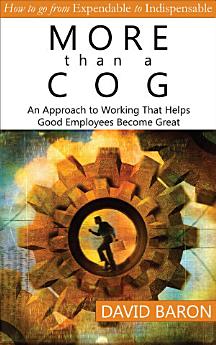More than a Cog: An Approach to Working That Helps Good Employees Become Great
About this ebook
than a COG” is a guide meant to help “regular” employees learn how they can get
more out of their jobs while becoming indispensable to their companies. For as
long as I can remember I have worked alongside some number of “regular”
employees. And they have all complained about their positions, their
compensation and their companies. And, they never understood why they were in
the positions they were, or why others (such as myself) were treated so
differently. Finally, after years of being exposed to such tribulations, and,
coupled with the past several years of hard times for the American work-force,
I decided to try to help all of those regular employees become more than
regular.
Are you a Cog in some
big machine of a Company? It’s OK – most
of us are. But are you secure in your
position within that company? Are you
getting recognized and compensated the way you think you should? Whether you’re flipping burgers for
McDonalds, bending fenders for GM or counting beans for Earnst & Young, you
need to be more than just another Cog – you need to be the best.
- Learn how great
employees: - Work at a career, not just a job.
- Don’t allow time, inexperience or overconfidence to limit them.
- Understand and honor the two-way relationship between themselves
and their company. - Make sure that everyone knows what needs to be known.
- Recognize and act upon opportunities to shine.
- Honor commitments that may have been made.
- Manage supervisor and customer expectation levels.
- Show pride in hard jobs done well.
- Take responsibility when things go wrong.
- Recognize that superiors and customers are partners for success.
This
ground-breaking manual for employees can show you how to increase your value to
your company, while increasing the amount of joy and pride you take in your
work.
Here are some of the strong points that the book
and its message have going for it:
- Reads easy - I am literally “talking” to the
reader. As a reader you can visualize me speaking to you, employee-to-employee.
The “conversation” feels personal, it feels natural. - Reads quickly - An interested reader should be
able to breeze through this book in two or three sittings. This is not some
dense, 1,000+ page tome, but more of a svelte manual, short and to the point. - Humorous and topical - I employ many references
to real life situations or popular theatrical arts that most readers will
identify with and enjoy. The stories help people feel more at ease, making it
easier to get the message across. - Surprising and Obvious at the same time - Just
like anything else that generates those wonderful “Ah ha” moments in life, this
book says things that will open peoples' eyes and make them feel surprised that
they “...never thought of that before.” And yet as you sit there, after reading
it, you will know that most people don't see what is so obvious. - High Goals Tempered with Realism - With each
lesson of “how to do things” comes a safety valve, a dose of reality, called
Caveats. Readers appreciate it when an author lets them know that he knows the
limits of his own advice. - Easy to Grasp - Each chapter presents a single
notion or technique. Plus the text is distilled down to its most basic message
in the final “take-away” that concludes each chapter. - Written by true authority - I am not some stuffy
college professor, a Wall Street analyst, or retired CEO. I am and have always
been, an employee – just a Cog. I am writing as one employee to another. I know
what I'm talking about, and it comes across that way. - A Needy Audience - The U.S. collegiate system
churns out several hundred thousand new employees per year, on top of the tens
of millions of workers already in the workforce. Nobody has been trained on
“how to work.” Without help, many of these people are sitting ducks. - Little Competition – There are dozens of books on
how to climb the corporate ladder, how to be an effective leader or successful
entrepreneur, how to be more organized, yada, yada, yada. But there are
practically no books on how to be a good employee. Managers make up less than
20% of any corporation. I'm interested in the other 80%, the people nobody
cares too much about - the common worker. - Timely - Now more than
ever, employees need to hear the message of this book. Employees need to learn
what they can so that they can hold on to the jobs they have.
About the author
David Baron has been a Cog for over 30 years. He has worked for companies ranging from 8 employee start-ups, to 120,000 person mega-corporations. With no managerial aspirations in sight, and in love with his work, he has dedicated himself to being the best employee possible. He wants you to do the same.







